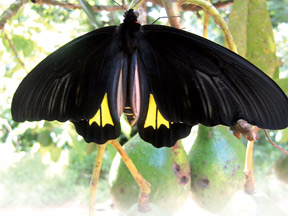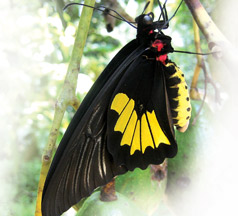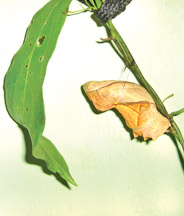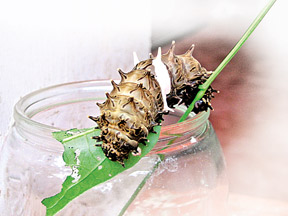|
Largest and the most magnificent :
Common Birdwing butterfly
by K. G. H. Munidasa
 |
|
Adult butterfly with
wings spread. |
 |
|
Butterfly soon after
emerging from pupal case |
The Common Birdwing butterfly Troides darsius "Siyothpiya" (Sinhala)
belongs to the family Papilionidae which is represented in Sri Lanka by
six General and 15 species, and are popularly called the Swallowtails,
though some are tail-less.
The Common Birdwing, perhaps the largest in the family with a
wingspan of between 150-180 mm. is peculiar to the island and occurs
throughout the lowlands and the hills, becoming scarce above 4,000 feet
elevations, and in the Northern districts.This fine insect may at once
be recognised by its large size and rich black and golden-yellow
coloration. It usually visits flowering plants in home-gardens,
especially hibiscus and lantana.
The Birdwing butterfly lays its eggs chiefly in the Aristolochia
indica or 'Sapsanda' creeper and occasionally in the betel wine. The egg
is normally deposited on the underside of a matured leaf or tender stem.
It is domed-shaped and bright yellow when laid, but turns brownish in a
couple of days. The newly hatched larva is about 3.5 mm. long, but grows
to a length from 60-62 mm. during its Larval period of between 28 to 31
days.
Description of larva: Cylindrical in shape and purplish-brown in
colour, with two dorsal and lateral rows of fleshy tubercles, those on
the eight segment and a streak from its base to the lower end of seventh
segment being pale pink. Between the tubercles are dark-brown streaks.
The pupation takes place in 28 or 31 days Description of pupa:
 |
|
Pupa on underside of stem of the
food plant |
 |
|
Full-grown larva |
Large, approximately 42 mm. long and 22 mm. broad (at the middle). It
is purplish-ochre in colour and bent backwards at the thorax, which is
conical and flattened on top with the sides angled. The wing case is
expanded and flattened laterally in the middle, with the outer edges
acute. Two middle segments of abdomen with a pair of conical
prominences.
Pairs of the Common Birdwing may often be observed to perform an
aerial display that is a wonderful example of animal behaviour in
nature. In the first place a female will slowly and nearly vertically
ascend to the air, followed at a short interval by a male butterfly.The
two keep about 2-3 feet apart, rising and falling in the air in perfect
unison, as if under the spell of a kind of magnetism.
This would recall to an observer's mind the flying of two paper
kites, one above the other, being activated by a common string.
Sometimes, a second or even a third finds itself drawn by the same
influence and follows suit.
The larvae of the Birdwing butterfly may easily be brought up to
maturity at home by any butterfly lover, feeding them on the usual food
plants.The pictures accompanying this article are those personally
photographed by the writer on different occasions of the butterfly he
has bred from egg to imago stage. |

